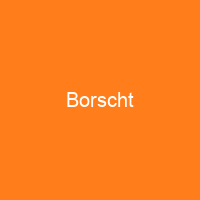Borscht is a sour soup common in Eastern Europe and Northern Asia. In English, the word is most often associated with the soup’s variant of Ukrainian origin, made with beetroots as one of the main ingredients. The same name is also used for a wide selection of sour-tasting soups without beetroots, such as sorrel-based green borscht.
About Borscht in brief

It was first popularized in North America by Yiddish-speaking Ashkenazi Jews from Eastern Europe. Some recipes call for smoked meats, while others use poultry or mutton stock. Fasting varieties are typically made with fish stock to avoid the use of meat, while purely vegetarian recipes often substitute forest mushroom broth. Parsley root, and tomato is often used as a root, or instead of fresh tomatoes, and may also be substitute for beans, swede, celeriac, zucchini or bell peppers. The vegetables most commonly added to borch are beetroot, white cabbage, carrot, parsley root and parsley. The soup is often served with smetana or sour cream, hard-boiled eggs or potatoes, but there exists an ample choice of more involved garnishes and side dishes such as uszka or pampushky, that can be served with the Soup. Its popularity has spread throughout Eastern Europe, the former Russian Empire, and – by way of migration – to other continents. In the U.S., it is most commonly associated with Jews or the Mennons, who brought it to North America from Europe in the 1930s and 1940s. It can also be found in restaurants in New York, Chicago, Los Angeles, San Francisco and San Diego.
You want to know more about Borscht?
This page is based on the article Borscht published in Wikipedia (as of Dec. 03, 2020) and was automatically summarized using artificial intelligence.







